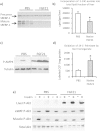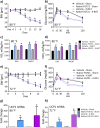FGF21 does not require interscapular brown adipose tissue and improves liver metabolic profile in animal models of obesity and insulin-resistance
- PMID: 26153793
- PMCID: PMC4495598
- DOI: 10.1038/srep11382
FGF21 does not require interscapular brown adipose tissue and improves liver metabolic profile in animal models of obesity and insulin-resistance
Abstract
FGF21 is a key metabolic regulator modulating physiological processes and its pharmacological administration improves metabolic profile in preclinical species and humans. We used native-FGF21 and a long-acting FGF21 (PF-05231023), to determine the contribution of liver and brown adipose tissue (BAT) towards metabolic improvements in Zucker rats and DIO mice (DIOs). FGF21 improved glucose tolerance and liver insulin sensitivity in Zuckers without affecting BW and improved liver function by decreased lipogenesis, increased fatty acid oxidation and improved insulin signaling. Through detailed lipidomic analyses of liver metabolites in DIOs, we demonstrate that FGF21 favorably alters liver metabolism. We observed a dose-dependent increase of [(18)F]-FDG-glucose uptake in interscapular BAT (iBAT) of DIOs upon FGF21 administration. Upon excision of iBAT (X-BAT) and administration of FGF21 to mice housed at 80 °F or 72 °F, the favorable effects of FGF21 on BW and glucose excursion were fully retained in both sham and X-BAT animals. Taken together, we demonstrate the liver as an organ that integrates the actions of FGF21 and provide metabolic benefits of FGF21 in Zucker rats and DIOs. Finally, our data demonstrates iBAT does not play a role in mediating favorable metabolic effects of FGF21 administration in DIOs housed at 80 °F or 72 °F.
Figures




References
MeSH terms
Substances
LinkOut - more resources
Full Text Sources
Other Literature Sources
Medical

